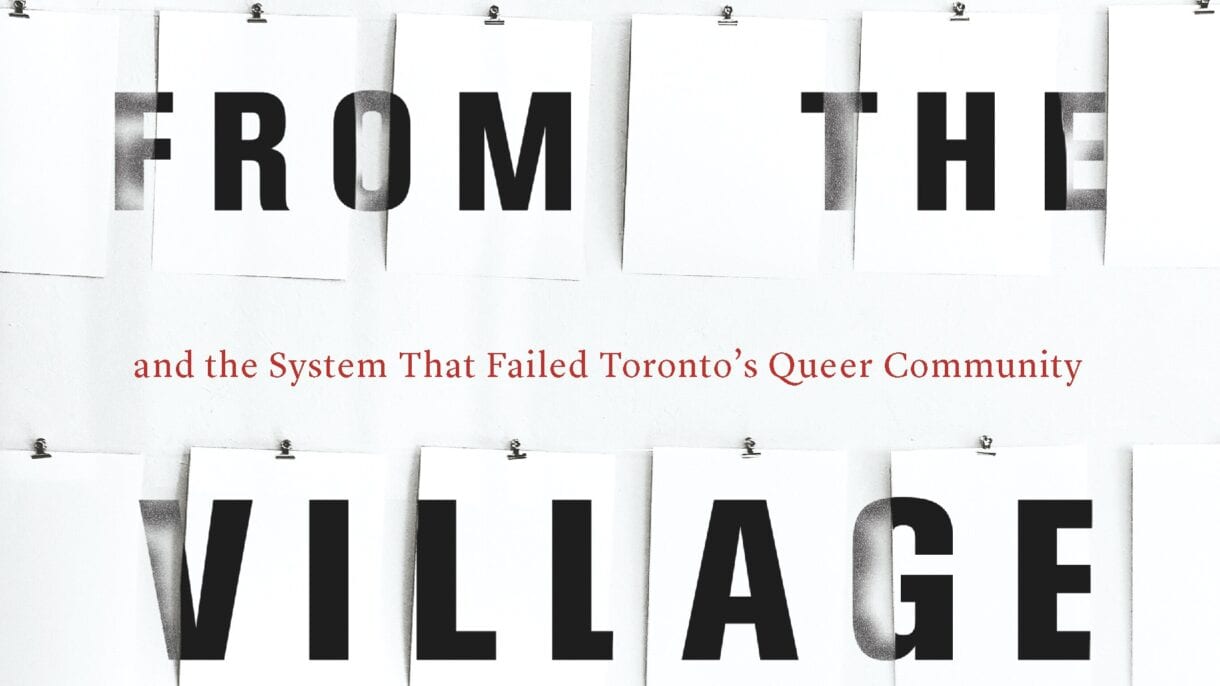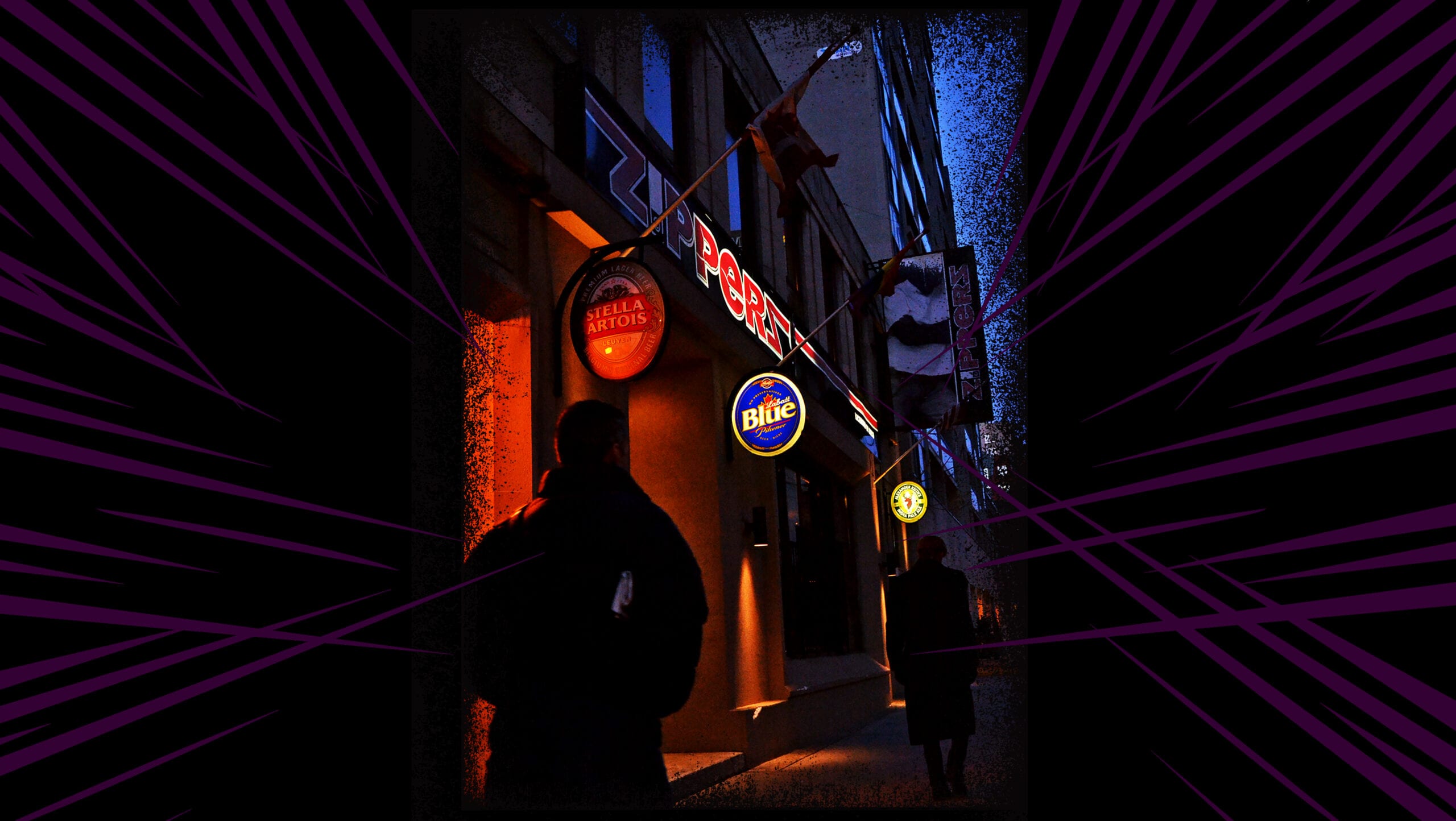A decade ago, men began to vanish from Toronto’s Gay Village—first three, then two more, then another. Eight men, six of them immigrants from racialized communities, were killed by Bruce McArthur, who was arrested in January 2018 and sentenced to life the following year. Journalist Justin Ling spent more than five years reporting on the men’s disappearances, and his first book, Missing from the Village, is a careful, infuriating study of the murders, the police inaction that failed to protect the community, and the lives these eight men left behind. This excerpt from Ling’s book, out Sept. 29, looks at the early days of the disappearances.
When Skanda Navaratnam, Basir Faizi, and Hamid Kayhan disappeared, they truly vanished. Joel Walker, Skanda’s friend, likened Skanda’s disappearance to an alien abduction. One second these men were sitting at the bar at Zipperz, the next they were gone.
Police did the requisite checks: their debt and credit cards hadn’t been accessed, their cell phones hadn’t pinged a cell tower, their emails hadn’t been opened. It felt like there was not so much as an indent in the grass where they had been standing.
The only piece of evidence that appeared in the weeks that followed their disappearances came in Basir’s case. He disappeared on December 29, 2010. In the first few days of 2011, someone called the city to report a decade-old Nissan that had been parked on their street since before the new year had rolled over. It’s the kind of neighbourhood where someone would notice a car out of place. A necklace of bright yellow parking tickets was strung across its windshield. A tow truck was dispatched and police ran the plates: the car was registered to an Abdulbasir Faizi, forty-four years old, of Brampton.
Of all the places within Toronto city limits for his car to be, Moore Avenue was one of the least likely. It was a ten-minute drive northeast of the Village, and the opposite direction from his home. On that stretch of the street, there were only single-family homes and a small park—you wouldn’t end up there unless there was something specific you were looking for. When I did that drive for the first time, it was not an intuitive route. From a home in the west end or from downtown, you’d need to drive east to Jarvis Street, head north, and take the Mount Pleasant exit, then drive along the winding street, passing dozens of residential streets, before finally taking a sharp right onto Moore Avenue.
It was an inflection point on the mystery. Why would Basir stop there?
There would be ample speculation in the months and years to follow. A local newspaper opined that Moore Avenue, flanked by Mount Pleasant Cemetery on one side and a park on the other, was an opportune spot to dump a car. That would compel internet sleuths, who may have read one too many Agatha Christie mysteries, to suggest Basir had been buried in the cemetery. When they found the car in early 2011, however, a search turned up no evidence of foul play. They guessed Basir had simply taken off and left his car somewhere it wouldn’t be immediately found—his family tended to agree. Police even have a phrase for those sorts of cases: the missing person simply vacated their life. Just the same, police knocked on some doors in the neighbourhood. Nobody knew anything.
At the time, nothing quite fit. If Basir had been robbed, a criminal would likely know better than to dump a car on a well-lit residential street. Toronto is not lacking for deserted areas to hide an automobile. If Basir had wanted to run away, it would make more sense to ditch his car within walking distance of a train station or the airport—though, to do that, Basir would have needed to bring cash or his passport, and he had neither. And, despite some active imaginations, hiding a body in a locked-up cemetery in a residential neighbourhood isn’t as easy as it seems.
Of the three disappearances, it was the most glaring piece of evidence to suggest something was desperately wrong.
There is another red flag, though. As a journalist, when I first began working on this story, it’s what struck me most. It’s that Skanda, Basir, and Hamid looked so similar. Here were three men who disappeared from the Village over just two years. If you walked into a room and saw the three sitting side by side, you could reasonably infer you had walked into a casting call. Middle Eastern or South Asian male. Forties or fifties. Beard.
Each family, each set of friends, toiled over these disappearances in their own way. Skanda’s friends put up posters, searched ravines and parks. Basir’s family took it upon themselves to search his email and computer for clues about his disappearance. Hamid’s friends and family worked with police to try and find him.
I have lots of theories as to why, after three men of colour disappeared in fairly quick succession, nobody in the broader city seemed to notice or care. Why this had not set off some kind of tripwire. When I began working on this story, I would argue at length about those theories. Sometimes I’ve even argued with myself. Sometimes I think, maybe their cases had too many differences to reveal their similarities. Skanda, openly queer. Basir, in the closet. Hamid, somewhere in between. It seemed that, despite drinking at the same watering holes, they didn’t even know each other.
But that is a poor explanation. I get angry about it. If three white women had vanished from the wealthy neighbourhood of Rosedale, just adjacent to the Village, their disappearances would have been national news. If three bankers had disappeared from the financial district, alarms would be going off immediately.
Why not these three?
While evidence of the men’s whereabouts was scant, the ripple effects of their disappearances were obvious. Skanda’s puppy was adopted. Basir’s wife had to go on without him. Hamid’s kids would never get to see their father again.
When Skanda disappeared, his friend Sarrah Becker joined the search. She remembered one day in particular, trudging through the rain, trying to shield the missing persons posters in her hands. She remembered thinking that the cops had just skimmed over his case. “He was an easy write-off,” she said. There was a prevailing theory held by investigators, she says: “Oh, he wasn’t murdered, he just went into hiding.” Sarrah couldn’t figure out how to feel. She would get pangs of anger at her friend, buying into the idea that he had picked up and run off, selfishly, without telling anyone. But then she shook her head, convincing herself all over that he wouldn’t do that. I suspect most of Skanda’s friends felt similar frustration. They were powerless to bring him back, but putting up those posters was one thing they could do. So they pushed the nagging doubt aside and walked to the next pole. They strode to the next bus shelter. The next shop. And the next one. And the next one.
On her way home from work one day, Sarrah began walking up the leafy Don Valley ravine, which cuts through the east end of the city. The ravine is a natural marker that the city grew around. Sarrah walked up the pathways of the ravine where they begin, near Cabbagetown, and wandered through until she came out around Greektown, where she lived. It was a grim walk. She took the long route, along the walking paths, her eyes to the ground, looking for something. She might have picked up a water bottle, or a discarded T-shirt, wondering if it was his, wondering if her friend’s body was somewhere in that ravine. The next day, she did it again. She found herself walking that route for eight years.
In early 2011, in the weeks after Basir went missing, his niece managed to get into her uncle’s email account. In there, she found his dating profiles and the conversations he had had with other men. This was all a revelation to his family. Even through the shock, his wife, Kareema, drove to the Village in hopes of discovering something about his disappearance. It had been so sudden, so absolute, that his family was left to conclude that it was a deliberate vanishing act.
Hamid’s friends and family, meanwhile, reached out to police to tell them as much as possible about him. His friends were open and blunt about his sexuality, his drug and alcohol use, his sexual habits. Opening your personal life like that is awkward and painful, but his friends hoped they could give police the information they needed to track him down.
At the time of each man’s disappearance, his face wound up on the list of news releases on the Toronto Police website. Their name, age, where they were last seen. But without evidence, the cases soon lost priority. Skanda’s and Hamid’s disappearances were the responsibility of the Toronto Police Service’s 51 Division. Because Basir technically lived outside of Toronto proper, his case was originally the responsibility of the neighbouring Peel Regional Police. As his car was found in Toronto, however, investigators from the city’s 42 Division conducted the search. Given Basir was last seen in the Village, Peel called up 51 Division, so it was detectives from that detachment who interviewed his friends in the Village, and spoke to patrons of Steamworks. But his case seemed to get lost in the shuffle, the responsibility of three different police silos and none at the same time.
The rituals that each group of friends and family performed are ones that will become increasingly common and incredibly frustrating in this story. There is the early rationalizing—that there is an innocent explanation for their friend’s or loved one’s disappearance. Later, the sliver of optimism—that some extraordinary circumstances led to their disappearance, but that they will come back some day. Then, the nightmares of them sitting at the bottom of a lake. The campaign to find a missing loved one sits exactly between hope and dread.
No answers come.
It was June 6, 2013—less than three years after Skanda disappeared, two and a half after Basir vanished, and nine months after Hamid’s disappearance was reported to police—that the three cases were suddenly thrust into the public consciousness.
With little explanation, police took to Church Street with freshly printed missing persons posters in hand, one page for each of the three men. “Investigators have concluded there are a number of similarities between the three men and they have not been seen since they were reported missing,” the police wrote in a press release. Suddenly, the three faces were everywhere in the Village.
Police had opened a full investigation into these three disappearances, assigning a dedicated task force—involving officers from 51 Division working out of headquarters—to get to the bottom of the mystery. Detective Deb Harris, a longtime veteran of the service, was tapped to head it up.
A reporter stood on Church Street, staring into the camera. “Those three men disappeared over a two-year span, but it’s only now investigators are making a connection.”
An officer stood in the polished atrium of police headquarters. “It’s quite unusual. Look at the circumstances surrounding this case—we’ve not heard or seen from them for several years now.” He goes through each missing man, underscoring the troubling details. “Is foul play suspected? That’s unclear.”
Sarrah Becker continued trudging through the Don Valley. Every day on her walk home from work, she detoured through the winding dirt tracks that lie beneath an overpass. Seeing the news that Skanda’s case was back on the radar of officers pushed her to redouble her efforts, staring more intently into the overgrown weeds and plants, behind concrete pillars and into gurgling streams. She had dreams, nightmares, about Skanda.
An activist, a racialized queer man, spoke to a reporter in the street. “There seems to be a thread in these three disappearances. It is unsettling.”
Hamid’s friend Kyle Andrews had been living in rural Nova Scotia for months, sitting in a tent. He didn’t even know Hamid was missing until he returned to Toronto. When he did, the missing persons posters bearing Hamid’s face were on every telephone pole in the Village. Kyle was jolted into reality. He dialled a mutual friend: “What the fuck?” When he saw Skanda’s and Basir’s faces, he had one thought. Kyle asked his friend a question that rang out as more of a statement: “Serial killer?”

Excerpted from Missing from the Village: The Story of Serial Killer Bruce McArthur, the Search for Justice, and the System That Failed Toronto’s Queer Community by Justin Ling. Published by McClelland & Stewart, a division of Penguin Random House Canada Limited. Reproduced by arrangement with the publisher.


 Why you can trust Xtra
Why you can trust Xtra


